3 Restaurant Management Tips To Engage and Retain Staff
2020 has been a rough year for restaurant managers.
You took orders over the phone and online, put on masks and gloves, and delivered meals to porches and curbsides. And all the while, your restaurant staff was there by your side, sweating and hustling to make it work.
While 82% of office workers were able to transition into primarily working from home in the wake of COVID-19 (according to our survey, methodology below), restaurant workers like you and your staff didn’t have that luxury.
That’s why now is a good time to check in with your restaurant staff to see how they’re feeling and how they think you can all move forward together into 2021 to build off your hard-earned experience together. And as you move forward, having regular check-ins to give and receive feedback is crucial to improving employee morale, keeping your staff engaged, and retaining your workers, which is a top priority for 32% of brick and mortar establishments according to our survey.
Why is engaging and retaining staff important for restaurants?
In any business, it’s less costly and more efficient to retain staff than it is to hire and train new staff. It’s just good business.
As a restaurant manager, you’re expected to supervise staff, ensure customer satisfaction, oversee food preparation, and manage scheduling, training, and compliance, among other things—all while the dishes are flying.
In other words, you don’t have time for a trial and error approach to your staff engagement and retainment strategy.
Here’s the good news: we already surveyed more than 100 U.S. restaurant staffers about their experience working with management to come up with these three restaurant management tips for developing your leadership skills and, as a result, improving service quality and staff morale.
This is the biggest takeaway we found from our survey: Restaurant managers must improve their feedback skills to boost staff engagement and retention or risk increasing turnover rates.
To bolster that point, executive chef and manager Patrick Stachelrodt told us “I would try my best to critique any inefficiency in physical labor, attempting to reduce wasted time but more importantly wasted effort. Workers doing tasks incorrectly is bad for the company as well as the employees … Collaboration is always key.”
Now, let’s look at three restaurant management tips to help you improve collaboration and efficiency.
Here’s what we’ll cover:
Tip 1: Deliver weekly feedback
Tip 2: Request feedback proactively
Tip 3: Regularly follow up on feedback
Key takeaways: How to become a better restaurant manager
Tip 1: Deliver weekly feedback
When was the last time you provided feedback—positive or negative—to your waiters?
According to our respondents, the most frequently their managers provided any form of feedback is “at least once a month,” followed by “at least once every three to four months” and “never.”
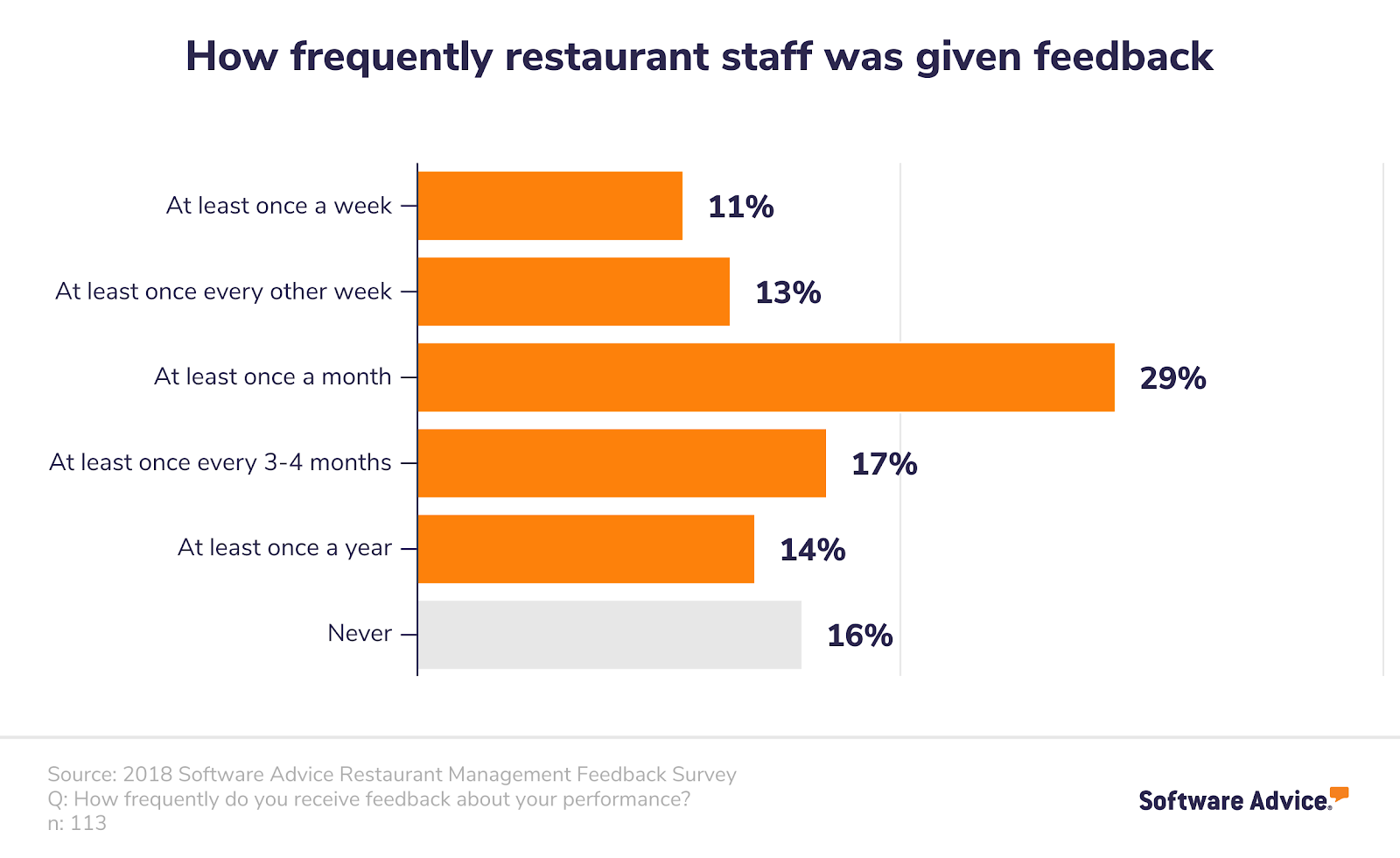
A survey of more than 1,000 U.S. workers found that 24% would consider leaving their job due to inadequate performance feedback from their manager.
Providing constructive feedback is the first step toward improvement for your employees. Without any sort of guidance or learning, employees can easily be caught in a loop of mediocrity. That’s where consistent feedback—be it words of encouragement or constructive critique—can serve to motivate them.
To address the challenge of providing regular staff feedback: Just like developing a muscle, giving feedback is a skill that can be honed with practice. Instead of making feedback a once-yearly or every six-month thing, make it a habit and a regular agenda item at the end of each week’s shift.
Why is it important for feedback to be ongoing? This way, it can be ingrained into your restaurant’s culture.
If you think that’s going to be time-consuming, consider the time it takes to prepare for an annual performance review, versus the time it’ll take for you to check in with your employees weekly. To think of it another way, would you rather brush your teeth twice per day, or have a root canal every year?
Consistent feedback is far more effective than feedback that’s provided six months later. By addressing an issue right away, employees have an opportunity to address those issues in a timely manner.
Tip 2: Request feedback proactively
As a manager, do you get feedback from your staff? If not, you should consider turning the tables back on yourself.
Over half of our respondents say they’ve “rarely or never” been asked to provide feedback to management while only 4 percent say they’ve “often” been asked.
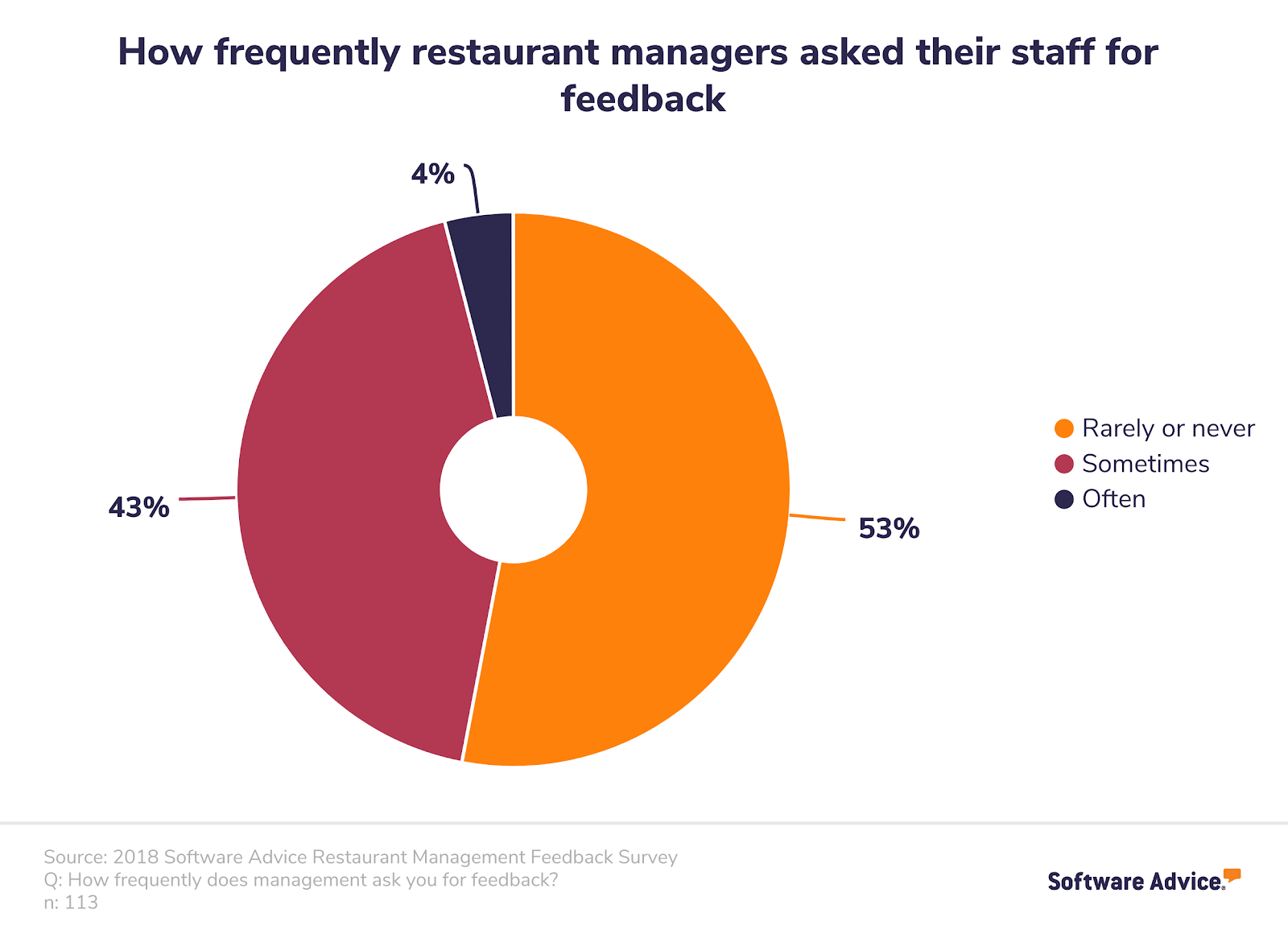
More often than not, feedback is given top-down. This can create feelings of resentment from employees who feel they are not being heard or fairly treated. It also hinders restaurant managers from learning how they, too, can work on their leadership skills.
Getting insight from your staff is important to understand what’s working—and what isn’t. It’s valuable for your team and reveals issues you might otherwise not be aware of.
Not only that, it also helps boost morale as it demonstrates how much you trust the concerns and judgment of your employees. In doing so, employees are more likely to be engaged and stay with your restaurant for the long haul.
To address the challenge of seeking feedback: Linda Hill, a professor of business administration at Harvard Business School, says bosses have to first set the stage to make employees comfortable with sharing feedback. Emphasize that everyone, including you, make mistakes and that you need their feedback to improve as a leader.
Even with an open-door policy, bosses would be mistaken to assume that staff will be immediately candid the first time they’re asked for feedback.
It’s important to be proactive when seeking employee feedback, says professor Ethan Burris of the University of Texas at Austin. “If you wait for people to make an appointment, it won’t work,” says Burris. “Instead of asking people to knock on your door, you need to knock on their door.”
Hill adds: “You have to do it for a while and then the information will flow and you can ask more pointed questions.”
To encourage a healthy culture of openness, candor and seeking consistent feedback must be the norm.
Want to find out what employees think about the latest changes in scheduling? Ask them directly. Want feedback about the new POS ordering system? Ask them what improvements they’d like made.
According to numerous studies, organizations where employees can voice their concerns freely see increased retention and stronger performance. In one instance, managers at a national restaurant chain were able to convince senior management to make changes that reduced employee turnover by 32 percent, saving at least $1.6 million a year.
Tip 3: Regularly Follow Up on Feedback
When we asked waiters how frequently management addressed their feedback to their satisfaction, the majority say “sometimes” and “rarely or never.”
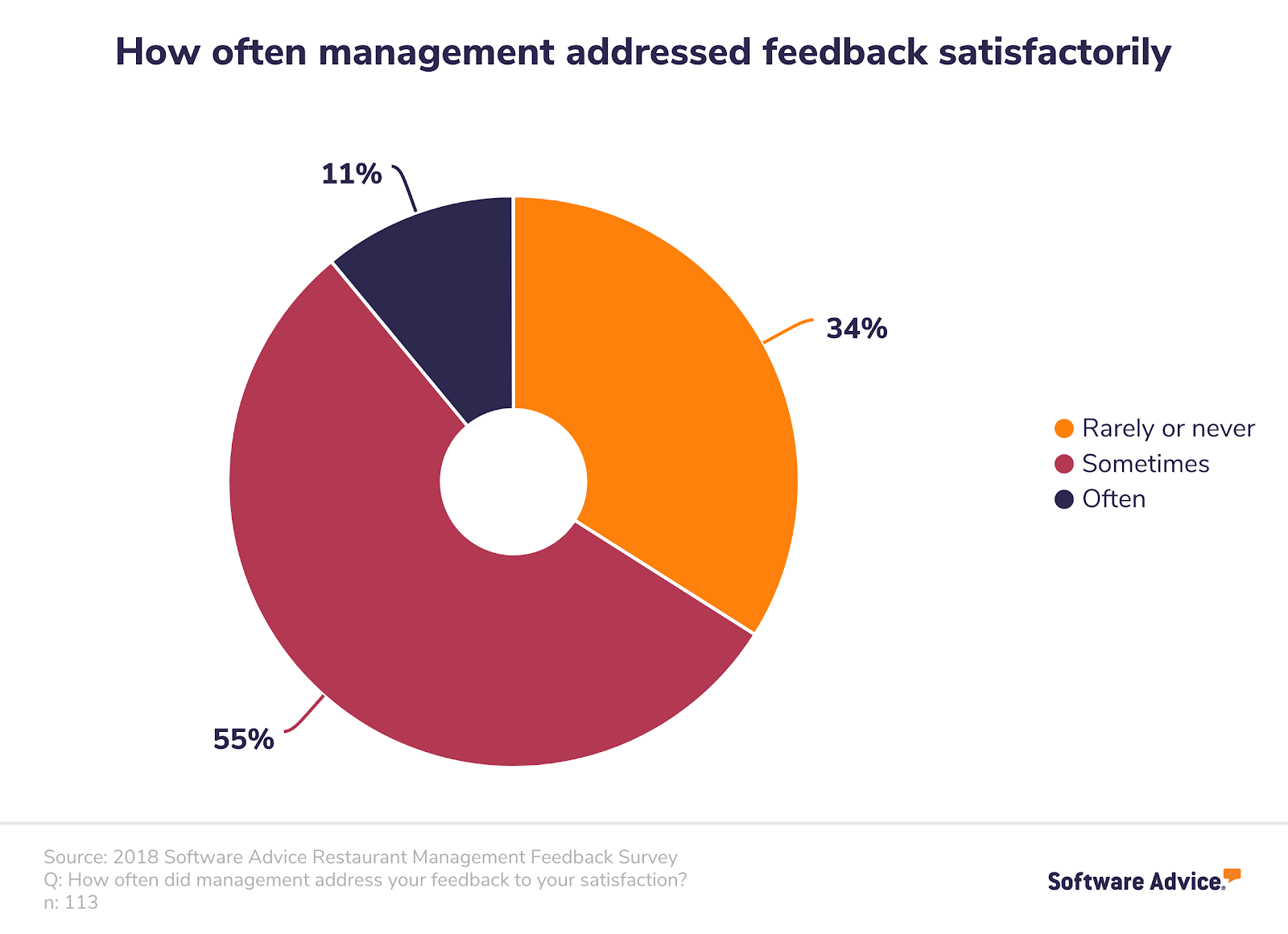
Asking for feedback and listening isn’t enough—you need to act on it. If an employee provides constructive feedback, acknowledge it. If employees don’t see that changes are being implemented based on their concerns, they’ll eventually become ambivalent.
“People hate feeling that speaking up was a complete waste of time,” says James Detert, associate professor at the Cornell Johnson Graduate School of Management. “You have to actually thank people for doing it, and other employees have to see those people get promoted rather than fired or shunned.”
To address the challenge of implementing staff feedback: Your response to the feedback provided by your employees is crucial. Even if the feedback is negative, be sure to thank them for their honesty and tell them you’ll take their input seriously and get back to them about their suggestions.
And regardless of what happens as a result of your employees’ feedback—whether their input results in changes being implemented or not—it’s important to acknowledge that you hear their concerns and value their input and time.
If the feedback you received is consistent, then it’s time to consider your performance and start implementing some changes.
If, however, you choose not to carry through with a suggestion your team offers, explain why you’ve made that decision. Your team will respect you all the more for it.
Another good reason to act on their feedback? According to Gallup, “employees expect and need resolution, and one of the best ways to do this is through action planning.”
As many as 80 percent of employees say they would work more hours for a more empathetic employer. Providing them with a sounding board to address those issues and acting on those concerns is a great way to demonstrate that.
Businesses can only reach their full potential with employees who are engaged—and your restaurant is no different. Engaged employees are more productive and show up ready to make a difference.
By indicating that their feedback is being listened to and acted on, restaurant managers can increase employee loyalty, resulting in employees wanting to go the extra mile at every shift.
Key takeaways: How to become a better restaurant manager
There’s a reason why this article focuses so much on feedback. Throughout our survey, respondents say giving, receiving and acting on feedback is a crucial component to embodying leadership attributes they need in a restaurant. To summarize:
Key takeaway #1: Giving feedback engages employees
If you’re in the business of managing people, providing feedback—whether constructive praise or critique—is vital to increasing employee satisfaction, engagement and performance.
Key takeaway #2: Ask for feedback
To engage employees, restaurant management must seek control of the situation and take more initiative to ask for feedback, rather than wait to receive it. Doing so will establish trust in employees and demonstrate that their concerns are valued and important, leading to an environment of ownership.
Key takeaway #3: Act on feedback
When restaurant management receives staff feedback well and acts promptly on it, employees will see that their feedback has been taken seriously. This will inevitably encourage more employees to provide constructive feedback, conveying to them a sense of ownership.
Restaurant management also calls for other crucial attributes necessary in managing a fast-paced food venture and leading a team of people.
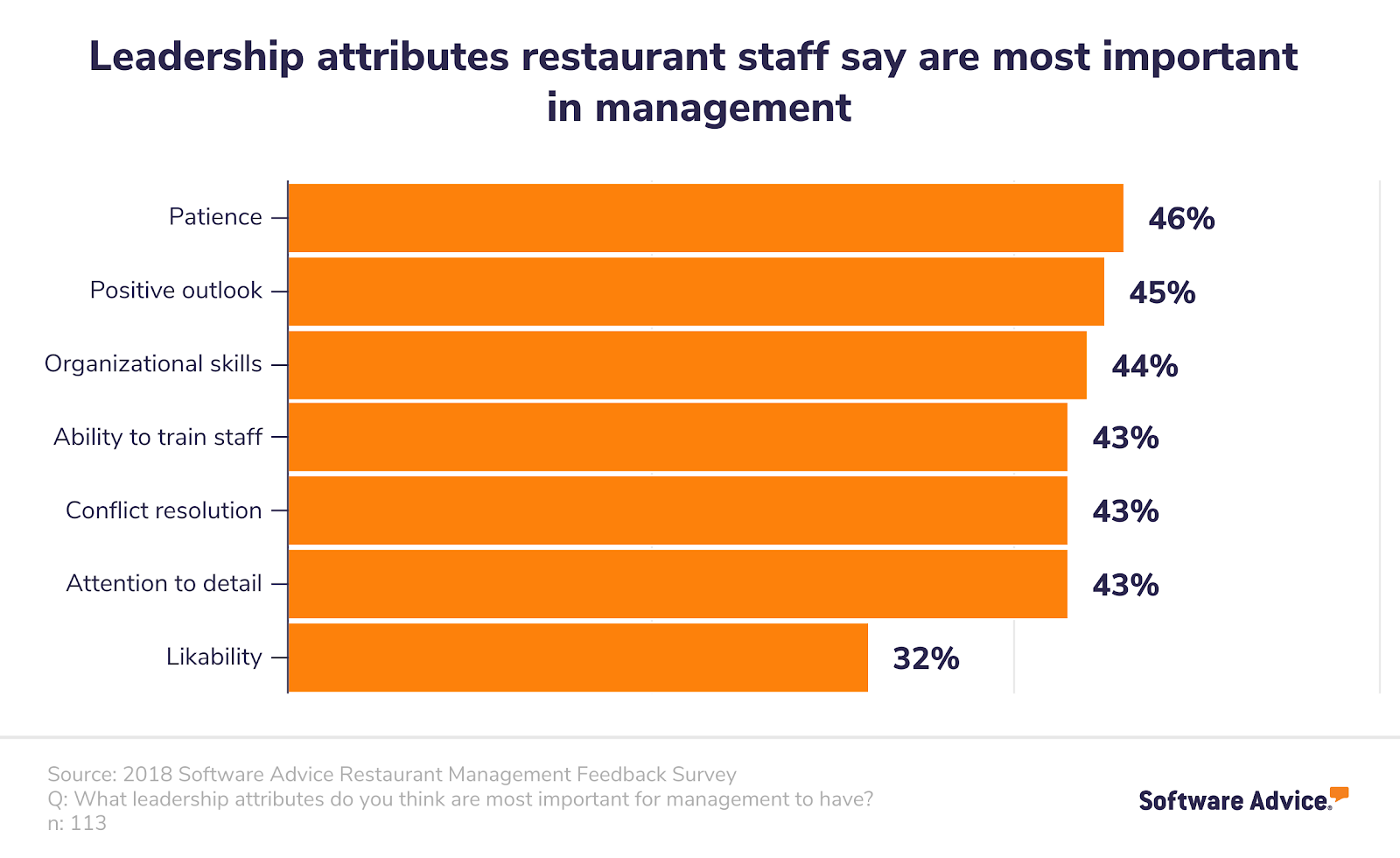
Patience emerged as the top attribute that close to half of our respondents say is necessary in their ideal manager, followed by positive outlook and organizational skills.
We’ve created a handy graphic that summarizes what leadership attributes to focus on and how they can impact your feedback strategy.
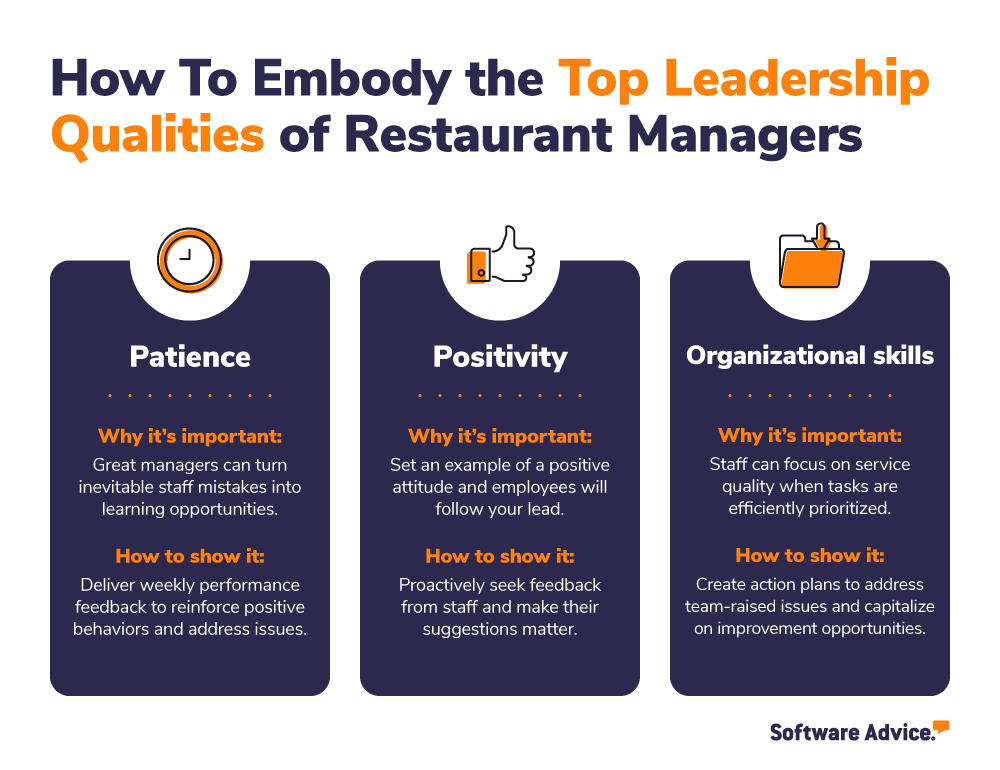
While these leadership qualities may be intuitive for some, others need to work at it—and that’s okay.
Former Green Bay Packer coach Vince Lombardi once said: “Contrary to the opinion of many people, leaders are not born. Leaders are made, and they are made by effort and hard work.”
You can accomplish that by following our tips above on how to give, ask and act on feedback. Doing so will ensure that as manager, you’re setting your restaurant up for success by establishing a positive work environment with less turnover, resulting in greater profitability.
Experiencing high restaurant turnover? Learn about staff retention strategies you can put in place today.
The Software Advice COVID-19 Consumer & Employee Impact Survey was conducted in June 2020 to understand how the priorities and preferences of people—as consumers, employees, and patients—have shifted due to COVID-19. We surveyed 564 consumers making up a representative sample (by age and gender) of the U.S. population.